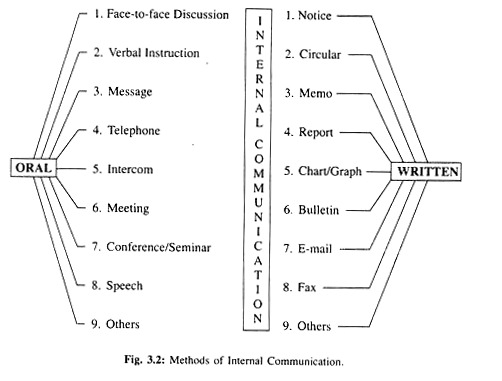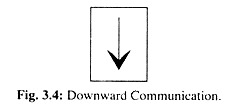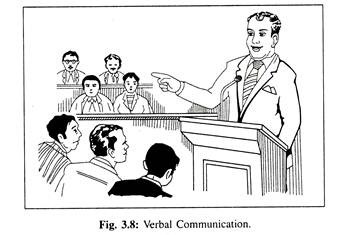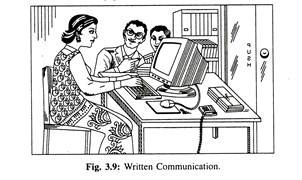Business Communication
Unit 1
Question Bank
- What is internal and external communication? Give examples for each.
(I) Internal Communication:
‘Internal Communication’ may be a process of communication made within the organisation between the superiors and subordinates or between peer persons or between two or more groups. It's going to be formal or informal, oral or written. It's going to flow upward, downward or horizontal as per requirement.
The oral means of internal communication are face-to-face discussion, verbal instruction, message, telephone, intercom, meeting, conference or seminar, speech, etc. The written methods include notice, circular, memo, report, chart or graph, bulletin, e-mail, fax, etc.

(ii) External Communication:
A business organisation has to communicate with the external agencies like customers, suppliers, investors, other business houses, banks, insurance companies, government offices, etc. Such communication could also be called ‘External Communication’ as its area of operation is with the people outside the organisation.
International business organisations got to communicate with foreign individuals, government agencies/organisations, etc. Oral external communication is formed through face-to-face discussion, meeting, conference, seminar, telephone, speech, etc. The written process includes notice, letter, telegram, report, e-mail, advertisement, fax, handout, etc.
2. What are the various directions in which communication flows in an organization?
(I) Vertical Communication:
Upward and downward flows of communication constitute ‘Vertical Communication’. In such kind of communication message or information is transmitted from the upper authority to the subordinates, and the other way around.
(a) Downward Communication:
Downward communication means the flow of data or understanding from the persons occupying higher positions to those at lower levels. It usually passes through written orders, reports and manuals and is the commonest feature of all business organisations. In the organisation, people at lower levels have a high degree of fear and respect towards such communication which results in high degree of its acceptance.

(b) Upward Communication:
Communication is claimed to be upward when it moves from the subordinates to the superior managers. Submission of reports and suggestions, opinions and attitudes, complaints and grievances belong to this category. ‘Upward Communication’ is less common because it's less favoured by the top managers because of its troublesome and perplexing nature.

(ii) Horizontal Communication:
‘Horizontal or Sideways Communication’ takes place between two subordinates or managers at an equivalent level and under an equivalent superior. It's especially important in large or decentralized organisations. Staff people help to transmit information among the positions and units at an equivalent level.

(iii) Diagonal Communication:
Communication among the executives or employees of various departments is named ‘Diagonal Communication.’ No definite direction is followed—upward, down-ward and horizontal communication takes place in it. Both oral and written means of communication are used. It's mainly informal. a good relation between the subordinates and superiors is made up. It's very useful in solving the issues and avoiding conflict, but the possibilities of spreading rumours are high.
3. How can communication be classified according to its various means?
(I) Verbal Communication:
‘Verbal or Oral Communication’ implies the transmission of orders, messages or suggestions through spoken words. It's going to be face-to-face or through a speaking instrument like telephone.

Verbal communication may pass directly between one person and another or group or indirectly through meetings and conferences. Whatever tool is employed, it saves much time and permits personal contact. This fosters a friendly and co-operative spirit, ensures quick understanding and proper explanation, encourages questions and answers, and stimulates interest.
The speaker is also during a position to understand the reaction of the listener. Again, it's best suited for confidential and emergent talks. But it's not suitable if the space between the speaker and therefore the listener is just too long. It's also unsuitable if the matter to be communicated is lengthy and is to reach many persons simultaneously. It also lacks recorded evidence and future reference and doesn't allow the listener much time to think, act, and react.
(ii) Written Communication:
A ‘Written Communication’ means the sending of message, order or instruction in writing through a letter, circular, manual, report, telegram, office memo, bulletin, etc. it's a proper method of communication and is suitable for long distance communication and repetitive standing orders. It creates the records of evidence and future reference, and may be sent to several persons at a time.

It gives the receiver sufficient time to think, act, and react. A written communication so as to be effective should be clear, concise and complete. Moreover, it's time-consuming and expensive, and it cannot maintain secrecy, offers difficulty in explaining all matters, has no chance of clarification, is less flexible and not effective in emergency.
(iii) Gestural Communication:
Communication are often made through movement of body, facial expression, smile, modulation of voice, sign, handshake, rubbing of hands, eye- to-eye contact, sort of walking, etc. As communication is formed through bodily gestures it's called ‘Gestural Communication.’

It should be kept in mind that, though the methods of communication are different, nobody method are often used exclusively. So, different methods could also be utilized in combination to suit the aim of the communication.
4. Define communication. What do you understand by the term ‘Business Communication’?
The word “Communication” has come from the Latin word “communis”, which suggests common. Thus, communication signifies sharing of ideas in common. The dictionary meaning of communication is to convey or exchange information and share ideas.
It is a process through which two or more persons transmit or exchange thoughts and concepts among themselves. Consistent with W. H. Newman and C. F. Summer, “Communication is an exchange of facts, ideas, opinions or emotions by two or more persons.”
Communication is that the process of transmitting information and understanding from one person to a different or from one unit to other unit with a view to getting the specified response from the receiver. Through this process two or more persons exchange ideas and understanding among themselves to attain the specified effect in the behaviour of another person.
In their book “Business Communication Today” C. L. Bovee, J. V. Thill and B. E. Schatzman write: “Communication is that the process of sending and receiving messages. However, communication is effective only the message is known and when it stimulates action or encourages the receiver to think in new ways.”
Communication made among persons to convey their personal information, message or thought are personal communication; but exchange of data, facts and concepts concerning business could also be termed as “Business Communication”. Business Communication refers to the communication concerning commercial activity which suggests providing goods and services to the consumers with a view to earning profit.
It is a process through which information, facts, ideas, orders, advices, decisions, etc. are conveyed, sent or exchanged between/among the persons related to business. Thus, Communication concerning trade, law, Finance, administration, management, etc. of a commercial enterprise could also be termed as ‘Business Communication’.
The success of a commercial enterprise depends largely upon good communication. Effective communication wipes out the hindrances in achieving the target of a commercial enterprise. Ineffective communication or communication failure may cause loss of cash, time, energy, opportunity and even goodwill of a business.
In this age of globalisation every commercial enterprise, big or small, requires proper communication for its existence. The success of any business largely depends upon successful communication.
In this age of speed, complexity and competition, sending of data regarding the product to the ultimate consumer is extremely important. Unless they understand the product of the business enterprise, it's impossible for them to create contact and buy the product. Communication plays an important role in this sphere.
5. What are the elements involved in the process of business communication?
ELEMENTS OF BUSINESS COMMUNICATION:
Business communication involves six basic elements. They're as follows:
- Message:
This is the subject-matter which is transmitted or gone by the sender to the opposite party or group of persons. This could be opinion, order, suggestion, attitude, feeling, view, etc.
2. Sender:
He/she is that the one that intends to form contact for passing information and understanding to another person.
3. Receiver:
The person to whom the message is supposed for is understood as receiver or communicates.
4. Channels:
Information is transmitted through certain channels (e.g., radio, television, telephone, letter, e-mail, etc.). The media is chosen by the sender considering various factors.
5. Symbols:
These are the words, actions and signs which are passed on by the sender while communicating with the receiver.
6. Feedback:
When the receiver acknowledges the message of the sender and responds back to him/her, feedback takes place. Without feedback communication is incomplete.
6. What are the fundamental features of business communication?
Business Communication has certain features or characteristics which enable us to differentiate it from other communication. A communication to be business communication must be:
1. Practical,
2. Factual,
3. Clear and brief,
4. Target-oriented,
5. Persuasive.
1. Practical:
Effective business communication deals with the sensible aspect of the information explaining why, how, when and therefore the like queries. It avoids impractical, imaginary, unnecessary or repetitive information to eliminate waste of time. It conveys important information to the receiver.
2. Factual:
In general, a business message contains facts and figures in place of overall idea. Important date, place, time, etc. should be clearly mentioned during a business communication.
3. Clear and Brief:
The language utilized in business communication should be simple, clear, brief and unambiguously. Sometimes charts, photographs, diagrams, etc. are used to condense or clarify the information.
4. Target-Oriented:
A business communication must have a selected objective and must be planned properly in order that the targets are often achieved.
5. Persuasive:
Business communication often plays a persuasive role. It persuades an employee to perform his/her duties, a customer to buy a product or service etc. the essential characteristics mentioned above are associated with the message or information of the communication.
7. What are the main characteristics of the process of business communication?
The process of business communication has certain other characteristics. They are:
- Integral a part of Management Process:
Communication encompasses those activities by which the ideas, opinions and decisions of the managers are conveyed to the subordinates of various ranks. It also involves the exchange of facts, feelings, suggestions and responses between the superiors and subordinates.
Communication, during this way, puts the people into action, guides and directs their activities, regulates and co-ordinates them for correct work performance. A manager, thus, performs the management functions through communication and managerial positions become the communication centres to receive information from various sources for its transmission to relevant points.
So, communication may be a part and parcel of management function, and is, thus, an integral a part of management process. That's why, Chester I. Bernard remarks, “the first executive function is to develop and maintain a system of communication”.
- Two-Way Traffic:
Communication doesn't only mean its downward movement from superior to the subordinates it implies both the transmission and reception. So, when conveying any information, a manager should know its reactions and responses. Otherwise, managerial task of guiding and directing are going to be ineffective.
A man should, thus, not only speak, inform and order, but should even be ready to listen, answer and interpret. Communication, therefore, involves two-way traffic from the managers to the workers and from the workers to the managers. It's not complete unless the message has been correctly understood by the receiver and its response becomes known to the sender.
2. Mutual Understanding:
The basic purpose of business communication is to cause understanding between individuals within the organisation. It's a crucial element for establishing human relationships. a pacesetter can lead and a manager can direct effectively by establishing perfect understanding with the subordinates, peers and superiors within the organisation.
The greater the degree of understanding presents within the communication the more possibility that act will proceed within the direction of accomplishing the goals.
3. Pervasive:
The subject-matter of business communication covers a large range and extends to all functions—purchases, production, sales, finance, recruitment, wages, dividends, market standing, innovation, productivity, etc. It also moves through all levels of management— upward, downward and sideways. Business communication is, thus, said to be a pervasive function.
4. Continuity:
Communication is an ever-present activity and without it an organisation cannot exist. Communication is as necessary to an organisation as blood circulation during a living body. Therefore, the managers should make sure that adequate and smooth communication flows altogether directions.
Breakdown of communication leads to misunderstanding, creation of unfavourable attitudes, hostility and conflict. So, communication must be a continual process and move up, down and sideways for active participation of all concerned.
5. Specific:
A business communication is usually specific in nature. It means a specific communication should deal with one subject at a time. This is often necessary for the effectiveness of communication. Multiplicity of subject during a communication has the likelihood of making confusion which is dangerous to sound management. It must be specific with reference to the information intended to be conveyed or received.
6. Result and not Cause:
Sound communication is that the results of competent management, not the explanation for it. Business communication may be a means to an end and acts as a tool within the hands of the managers. Successful handling of this tool depends upon the competence of the managers. It's not an independent activity, rather an important ingredient of managerial function.
So, good communication doesn't produce good manager. But good manager is almost always an honest communicator. Misconception of management process often results in poor communication.
7. Internal and External:
Business communication is primarily internal. It is, thus, a neighbourhood of administrative function and intended to use to the members belonging to an organisation. Orders, instructions, suggestions and even public notice announcing the annual general meeting of a corporation are a number of the examples of internal communication.
But nowadays, many communications move beyond the organisational horizons and touch the surface population exceeding the organisation’s own (e.g., advertisement). Business communication may thus be internal and external.
8. Different Types:
Business communication could also be of various types—formal, informal, upward, downward, sidewise, written, oral, etc.
9. Feedback:
A communication can't be complete unless and until feedback or response of the recipient is formed. Feedback could also be written, oral or gestural. Sometimes mere silence can also constitute a feedback.
8. What role does positive attitude play in improving communication?
When it comes to communication, it's better to have a positive attitude than to struggle to make the other person see how your argument is right. Below are the reasons why a positive attitude is considered significant for effective communication:
- Communication becomes an easier, more pleasant experience when you maintain a positive attitude, regardless of how the other person is communicating or refusing to communicate with you.
- Positive attitude keeps you serene even when you are being unjustly accused, or when you are being spoken to in a caustic, irritated, impatient manner that you could easily take offense to.
- Positive attitude for smooth communication experiences is the attitude that expresses there is nothing going wrong here and there is nothing to worry about. There is no need to struggle or compete for any particular outcome. We are two individuals with purely good intentions for one another.
- The only way of being right that really matters during communication is being in the right state, which is the state of inner peace, harmony, compassion and mutual respect and appreciation. As long as you maintain this positive state, you avoid becoming ensnared in destructive conflict.
- Your emotional state is a product of your attitude. If you maintain a positive attitude that you are perfectly safe, with nothing to prove, you will feel secure and happy during the conversation.
- The moment you make it your responsibility to get through to the other person despite that person's resistance, you set yourself up for a draining, hurtful, frustrating power-struggle.
- The only point of view that is your responsibility is your own. If your perspective is working for you, keep it. If it is not, let it go.
- One perspective to let go of is the one that tells you that another person's point of view is your responsibility. This perspective expresses an attitude of dependency that disempowers you and sets you up to feel like a helpless victim.
- A positive attitude maintains and preserves your power by remembering that you are not responsible for making anyone say, think, feel or do anything. It is what you say, think, feel and do that determines what happens to you.
- As you maintain the attitude of self-confidence regarding your ability to have your needs met with or without this particular person's agreement or cooperation, your attitude avails you of the means to meet your needs without having to waste your energy on a power-struggle with that other human being.
- Don't imagine going through any kind of significant loss without this particular person's agreement. Maintain an attitude that trusts that what is best for you will happen without you having to try to force anyone else to see things your way.
- You don't have to get through to anyone; you don't have to convince anyone that you are right; you don't have to make anyone see things your way. You can offer your perspective, but if it is not accepted, or if it is directly opposed, maintain the attitude that you really don't need that person's acceptance of what you have to say.
- Maintain a positive attitude that you really don't need the agreement, understanding or cooperation of anyone who does not freely give it.
- Communication sometimes flashes like lightening, but at other times it is an organic process. The other person may not be ready to fully grasp or appreciate the message you are offering. It may take him some time to reflect on what you have said for agreement to bloom. It may require that you revisit the topic again and again from time to time to nurture the seed of understanding that you have planted.
- Maintain a secure, confident attitude toward communication. If the other closes the door on what you have to say, trust that this is as it should be, that you didn't need that door to open for you to be safe, secure, happy and successful.
- Interestingly, by maintaining this balanced, non-forcing attitude toward communication you will probably find others more receptive to what you have to say.